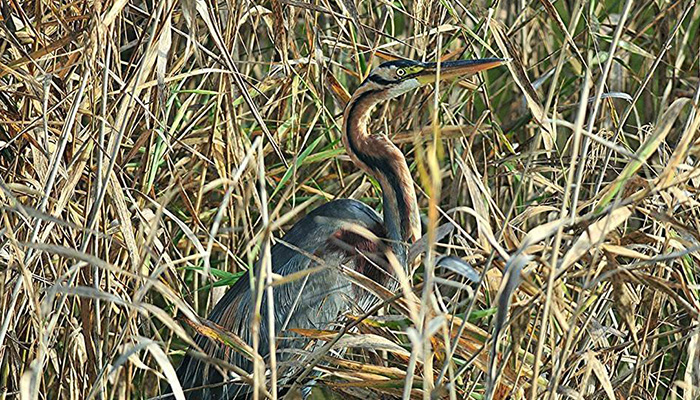 English: Purple Heron
English: Purple Heron
Russian: Рыжая цапля
German:
Purpurreiher
French: Heron
pourpre
Mongolian: Зээрд дэглий
Japanese:ムラサキサギ(Murasaki-sagi)
Body
length: 70-90
cm
Wing
span: 120-138 cm
Status: Rare species. According to the IUCN Red List Categories and criteria,
the species evaluated as-Near Threatened.
Distribution and range in Mongolia: Khalkh, Nomrog rivers
valley, wetlands of the Buir lake, Tashgain tavan nuur lake (Buir lake, Khalkh
river-Khyangan region), Bayan lake, estuary of Ulz river, Mongol Daguur and
Ogii lake, Terkhiin Tsagaan lake. Recorded a pair nesting with 3 chicks in June
2003 near Buir lake of Khalkh river.
Habitat: Breeds
in colonies at extensive, shallow swampy lakes with reedbeds. Forages in
shallow water in gaps among reeds and along rivers, or more in open in wet
meadows. Summer visitor, wintering in tropical Africa. Feeds on fish, frogs,
insects. Nests in reeds or trees.
Identification:
Big, lanky heron, usually quite dark-looking in the field. Main confusion risk
is Grey Heron. Note the following differences: longer, more uniformly narrow
bill; narrower head; wings in front view slightly bent at carpal, and hint of
jerkiness in wingbeats; somewhat narrower neck, which in flight often forms
more angular ‘neck keel’; longer toes, sometimes held more splayed and
disarranged; slightly smaller size.
- Adult:
Head-sides and neck-sides reddish-brown, neck with distinct, thin black border.
Back dark grey, wing-coverts uniform dark grey with purple-brown cast.
- Juvenile/1st-winter:
Head and neck-sides, back and upperwings ochre-brown, upperparts mottled
(feather centres dark, fringes ochre), dark margins along neck-side indistinct.
1st-summer: Neck and back almost as adult, but wings still variegated brown.
Population and Threats: Global population is 270.000-570.000, breeding grounds spread
over 22.400.000km2 territory. In Mongolia, inadequate information on population
and threats data. Range is limited.
Conservation Measures: Included as Rare animal in the Annex to the Mongolian Government
Resolution #7 (2012). Range is included within the Mongol Daguur, Nomrog
Strictly Protected Areas, as well as included within the Buir lake and Terkhiin
Tsagaan lake, surrounding wetlands Ramsar sites, according to the Ramsar
Convention.
Further actions: Study is distribution, population abundance, reproductive biology
and ecology research, protect reeds and vegetation cover in the nesting and
breeding habitats, improve the conservation management, raise awareness.